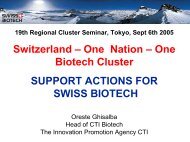Abstract
Abstract
Abstract
You also want an ePaper? Increase the reach of your titles
YUMPU automatically turns print PDFs into web optimized ePapers that Google loves.
(2) Chemical synthesis and nanoscience<br />
In life science and nanoscience, as research at the molecular level progresses, the territory of<br />
"chemistry" is broadening. Nanoscience is steadily developing. As can be seen in the Science Map,<br />
the volume of research linking chemical synthesis and nanoscience is increasing.<br />
<br />
Research on asymmetric synthesis using organic catalysts<br />
showed a rapid increase. Understanding nature at the level of<br />
chemical structural formulas is fundamental to chemistry. With<br />
life science and nanoscience research at the molecular level<br />
progressing, the territory covered by chemistry is expanding. On<br />
the Science Map, chemistry is located between life science and<br />
physics, reflecting this situation.<br />
<br />
Nanoscience is steadily progressing. In the Science Map 2004,<br />
"Development of nanostructure and its application to molecular<br />
devices (2004, ID 106)" is observed as a single research area. It<br />
has since expanded to three independent research areas, "Study<br />
on supramolecular nanodevice by molecular machine and<br />
single-molecule conductor (2006, ID 86)," "DNA-nanomaterial<br />
and nanodevice (2006, ID 87)," and "Study on synthesis and<br />
optical application of metal and metal oxide<br />
nanoparticle/nanostructure (2006, ID116)." As can be seen in<br />
the Science Map (See Figure 5), the volume of research linking<br />
chemical synthesis and nanoscience is increasing.<br />
Figure 5: Increase in research areas<br />
between chemical synthesis and<br />
nanoscience<br />
【Projected figure】<br />
【Science map】<br />
Density distribution of Papers<br />
Science Map<br />
2004<br />
Chemical synthesis<br />
Data: Tabulated by the National Institute of Science and<br />
Technology Policy based on Thomson Reuters’<br />
"Essential Science Indicators"<br />
Nanoscience<br />
Science Map<br />
2006<br />
Chemical synthesis<br />
Nanoscience<br />
(3) Condensed matter physics and particle physics/cosmology<br />
In condensed matter physics, quantum computing and superconductivity were extracted as hot<br />
research areas. Launch of the European Organization for Nuclear Research's (CERN) Large<br />
Hadron Collider (LHC) will be a large step for particle physics/cosmology. Discoveries of new<br />
phenomena and verification and testing of theories will take place.<br />
<br />
Condensed matter physics includes hot research areas related to quantum computing and superconductivity.<br />
Comparing the Science Map 2004 with the Science Map 2006, the number of research papers in<br />
"Ferromagnetic semiconductor spintronics (2006, ID 55)" and "Electrical control of spin in<br />
semiconductors/quantum computer using solid state components (2006, ID 57)" increased. Experts suggested<br />
that while the location of condensed matter physics in between chemical synthesis and particle<br />
physics/cosmology on the map will probably not change, the hot research areas are likely to change with the<br />
times.<br />
<br />
Comparing the Science Map 2004 with the Science Map 2006, the hot research areas from 2004 generally<br />
continued, although some merged. This is because particle physics/cosmology has ultimate goals such as the<br />
unification of force fields and understanding of the origin of the universe, and research continues to evolve in<br />
those directions. Relationships between particle physics/cosmology and other groups of research areas were<br />
viii




